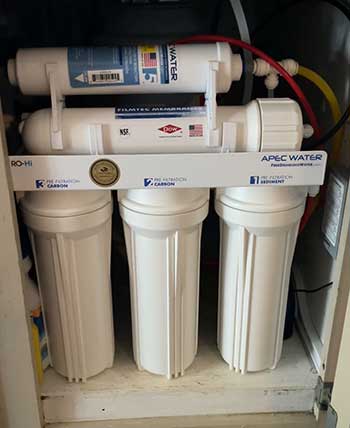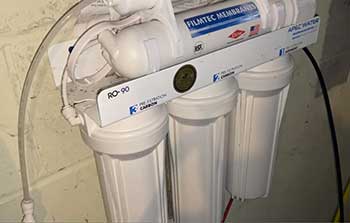Reverse osmosis (RO) water filtration systems are an effective way to remove contaminants from water in your home. Two popular options are the Apec RO-Hi and RO-90 models.
But what’s the difference between these two systems, and which one is better for your needs? This comprehensive guide examines the pros, cons, features, and performance of Apec’s RO-Hi and RO-90 to help you decide.
A Brief Comparison Table
| Feature | Apec RO-Hi | Apec RO-90 |
| Stages | 5 | 4 |
| Daily Production | 90 gpd | 90 gpd |
| Storage Tank | 4 gal. | 4 gal. |
| Booster Pump | Yes | No |
| Water Pressure Req. | 40-80 psi | 50-100 psi |
| Dimensions | 16 x 5.25 x 18 in | 16 x 5.25 x 18 in |
| Weight | 24 lbs | 22 lbs |
| WQA Certified | Yes | Yes |
| Warranty | 1 year | 1 year |
Overview Of RO Filtration
Reverse osmosis uses pressure to force water through a semipermeable membrane that removes dissolved minerals, metals, salts, and other contaminants. The membrane has tiny pores that block the passage of larger particles while allowing water molecules to pass through.
The advantages of RO systems include:
- Removes up to 99% of contaminants and impurities
- Improves water taste and odor by reducing chlorine and chemicals
- Softens hard water by removing calcium and magnesium
- Helps prevent scale buildup on fixtures and appliances
- More thorough filtration compared to water pitchers and faucet filters
Some drawbacks of RO systems are:
- Wastewater production: For every gallon of purified water produced, 3-5 gallons go down the drain
- Removes healthy minerals like calcium and magnesium
- Requires more frequent filter changes than other types of filtration
- Installation can be complex for under-sink and whole-house systems
Now let’s see how Apec’s popular residential models, the RO-Hi and RO-90, compare in their performance, features, and price.
Apec RO-Hi Overview
The Apec RO-Hi is a under-sink reverse osmosis system designed for homes with high contaminant levels in their water supply.

Key features:
- 5-stage filtration process
- Removes up to 99% of contaminants
- Purifies 90 gallons per day (at 60 psi water pressure)
- WQA Gold Seal certified
- 1-year warranty on parts
This model uses a 5-stage filtration process:
- Sediment prefilter – Removes sediment, dirt, rust, and other particles
- Granular activated carbon filter – Reduces chemicals, pesticides, chlorine, and improves taste
- RO membrane – The heart of the system that rejects dissolved solids, salts, metals, etc. through reverse osmosis
- Carbon post-filter – Provides final polishing and removes any residual tastes/odors
- Inline booster pump – Increases water pressure to optimal level for RO membrane
The included permeate pump provides consistent water pressure and improves the efficiency and life of the RO membrane. The end result is purified water with exceptionally low total dissolved solids (TDS).
Apec RO-90 Overview
The Apec RO-90 is a more affordable reverse osmosis system designed for homes with moderately contaminated water supplies.
Key features:

- 4-stage filtration process
- Removes up to 90% of contaminants
- Purifies 90 gallons per day (at 60 psi water pressure)
- WQA Gold Seal certified
- 1-year warranty on parts
It uses a simplified 4-stage process:
- Sediment prefilter
- Granular activated carbon filter
- RO membrane
- Inline carbon post-filter
While it lacks the booster pump of the RO-Hi, the RO-90 still provides efficient filtration down to 0.0001 microns to remove the vast majority of impurities. It’s an economical option for anyone seeking cleaner, healthier water. The main compromise is that the RO-90 may not reduce TDS levels as much as the RO-Hi on very contaminated supplies.
Filtration Performance Comparison
Both Apec systems use industry-leading Dow Filmtec RO membranes to provide exceptional contaminant reduction:
- TDS removal: Up to 99% (RO-Hi), up to 90% (RO-90)
- Micron size filtration: 0.0001 microns
- Chlorine removal: 90-99%
- Heavy metals removal: 98-99%
- Microorganism removal: 99%
However, the RO-Hi’s 5-stage process with its permeate pump optimizes the system’s performance for high contaminant levels. Homes with very hard water, high TDS, or water safety concerns may benefit from the RO-Hi’s superior filtration capabilities.
Also Read: Choose Between APEC ROES 50 And RO 90.
Daily Production Rate
The RO-Hi and RO-90 are both rated to produce 90 gallons of purified water per day at ideal 60 psi water pressure. This equals roughly 5 gallons per hour of continuous use.
At lower household water pressures, the RO-90’s output may be reduced more than the RO-Hi. The RO-Hi’s booster pump helps overcome lower pressure from the water supply line.
For most households, 90 gallons per day provides sufficient purified water for drinking, cooking, beverages, and ice cubes. Larger families or heavy water users may prefer an RO system with an even higher capacity.
Convenience Features
Ease of installation – The RO-90 has a more straightforward under-sink installation without the booster pump wiring. The RO-Hi requires installing the pump but comes with clear instructions.
Tank size – Both systems come with a standard 4 gallon pressurized storage tank. Larger tanks are recommended for households with higher water usage.
Faucet options – A matching chrome faucet optimized for RO water is included with both models. A designer faucet can be purchased separately.
Feed water connectors – The units connect to the cold water line with included feed water adapter tees and valves. No splicing into pipes required.
Drain saddle – Quickly attaches to the sink drain pipe to direct wastewater from the RO to the drain. No permanent mods needed.
Status indicators – LED lights on the tank show the system status and warn when filters need to be replaced. Takes the guesswork out of maintenance.
Noise level – Both systems operate very quietly. The RO-Hi’s pump emits a soft hum but won’t disturb you.
Overall, the models are equal in their convenience and ease of installation. The RO-90 gets a slight edge for simpler under-sink hookup.
Also Read: Is Waterboy Better Than LifeSource?
Reliability & Durability
With proper maintenance, Apec’s systems are designed to provide years of reliable service. Both models use premium components that exceed industry standards for durability:
- Filters – Submicron sediment filters protect against premature fouling. The carbon block post-filters last 1 year.
- Pump – The RO-Hi’s booster pump is engineered for 24/7 operation and quiet performance.
- Membrane – The high rejection membranes have a 2-5 year lifespan under normal conditions.
- Fittings & tubing – Leak-proof stainless steel fittings and 1/4 inch tubing resist corrosion.
- Frame – The powder coated steel frame prevents rust and stands up to abuse.
- Warranty – Apec provides a 1-year warranty on parts for both the RO-Hi and RO-90.
While their components are comparably robust, the RO-Hi’s permeate pump is one additional piece that could potentially fail. But overall, both systems earn high marks for durability.
Filter And Membrane Replacement Costs
With regular use, the sediment prefilter, carbon blocks, and RO membrane will need periodic replacement. Here are the estimated costs:
- Sediment prefilter – $20 (once yearly)
- Carbon block filters – $60 ($30 each, once yearly)
- RO membrane – $120 (every 2-5 years)
Replacement filters and membranes are readily available from Apec and third party suppliers. Prices can vary, but costs are typically equal for either system.
The RO-90 has the slight advantage of one fewer carbon filter to replace yearly. But one additional membrane replacement for the RO-Hi every few years helps equalize long term costs.
Initial Purchase Price
As Apec’s higher tier offering, the RO-Hi carries a significantly higher MSRP:
- Apec RO-Hi – $495
- Apec RO-90 – $309
However, the systems can both be found online for prices discounted 15-25% off MSRP:
- RO-Hi – Approximately $370
- RO-90 – Approximately $230
At $140+ more, the RO-Hi commands a 55-60% price premium over the RO-90. For many households trying to save money, the more affordable RO-90 provides the biggest bang for the buck.
Also Read: Comparison Between APEC and Express Water
Also watch the video about Apec RO-Hi!
Frequently Asked Questions (FAQ)
90 gpd stands for 90 gallons per day, which is the maximum purified water production rate for the Apec RO-Hi and RO-90 systems. At optimal water pressure, they can each produce up to 90 gallons of filtered water daily.
The “best” RO system depends on your specific water quality issues and needs. Top brands like Apec, iSpring, and AquaTru offer excellent performance. Key factors to consider are contaminant removal capabilities, daily production rate, convenience features, and cost. An under-sink system with 3+ stages is ideal for most homes.
The two main types of reverse osmosis systems are under-sink and whole-house. Under-sink RO systems filter a water line at one tap, usually the kitchen sink. Whole-house ROs filter all the water entering a home but have a higher upfront cost.
Three common reverse osmosis system types are:
Under-sink RO systems
Whole-house/point-of-entry RO systems
Countertop/tabletop RO systems
Under-sink systems are the most popular for the average home. Whole-house systems filter all household water but are more expensive. Countertop RO units are affordable but slower and less convenient.
Also Read: How Do EveryDrop Water Filter 1 and Filter 2 Compare?
Conclusion
For households seeking exceptional contaminant reduction, the Apec RO-Hi is the superior system. Its 5-stage process with permeate pump provides the highest quality water even with very contaminated source water. But you pay a significant price premium for the RO-Hi.
For most homes with moderately hard water, the Apec RO-90 offers tremendous value. It removes up to 90% of impurities at nearly half the cost of the RO-Hi. You still get high quality components and proven performance, just without the booster pump optimization.
Ultimately, choosing between the two models depends on your specific water quality issues and budget. Be sure to test your water’s TDS, hardness, and contaminant levels first to determine if you require the RO-Hi’s maximum filtration capabilities.
For moderately contaminated supplies, however, the affordable Apec RO-90 will suit most homes very well.
